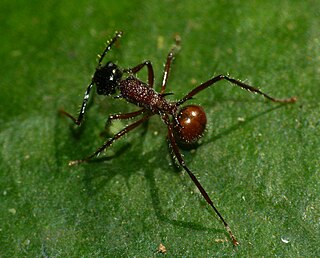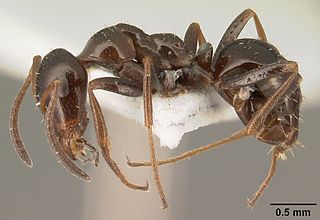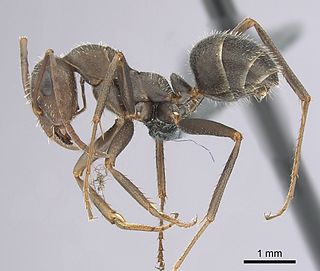
The Formicinae are a subfamily within the Formicidae containing ants of moderate evolutionary development.

Myrmecophytes are plants that live in a mutualistic association with a colony of ants. There are over 100 different genera of myrmecophytes. These plants possess structural adaptations that provide ants with food and/or shelter. These specialized structures include domatia, food bodies, and extrafloral nectaries. In exchange for food and shelter, ants aid the myrmecophyte in pollination, seed dispersal, gathering of essential nutrients, and/or defense. Specifically, domatia adapted to ants may be called myrmecodomatia.

Cardiocondyla is an Old World genus of ants in the subfamily Myrmicinae.

Cataglyphis is a genus of ant, desert ants, in the subfamily Formicinae. Its most famous species is C. bicolor, the Sahara Desert ant, which runs on hot sand to find insects that died of heat exhaustion, and can, like other several other Cataglyphis species, sustain body temperatures up to 50°C. Cataglyphis is also the name of an autonomous rover that won the NASA Sample Return Robot Centennial Challenge inspired by the navigation approaches used by desert ants.

Myrmoteras is a genus of ants in the subfamily Formicinae and the sole member of the tribe Myrmoteratini. They have enormous eyes, a character found in other ancient genera, and extremely elongated mandibles with eight to 16 teeth. These work as trap-jaws and can open up to 270°.

Acropyga is a genus of small formicine ants. Some species can be indirect pests. A. acutiventris, which is found from India to Australia, tends subterranean, root-feeding mealybugs of the species Xenococcus annandalei. Living, gravid females are carried in the jaws of A. acutiventris queens during their nuptial flight, to establish the symbiotic association in founding colonies. Other Acropyga species have relationships with different species of mealybugs, and it could be a trait common to the whole genus.

Aenictus is a large army ant genus distributed in the Old World tropics and subtropics. It contains about 181 species, making it one of the larger ant genera of the world.

Cryptopone is a genus of ants in the subfamily Ponerinae. The genus has a worldwide distribution, with most species occurring in Asia. Workers range from very small to medium in size (1.7–6.1 mm), with the queens being slightly larger.

Polyrhachis is a genus of formicine ants found in the Old World with over 600 species. The genus is yet to be comprehensively resolved and contains many varied species including nest-weavers, swimming workers, soil and tree-dwellers. First fossil record of this genus was P. annosa from Miocene.

Probolomyrmex is a genus of ants in the subfamily Proceratiinae. The genus is distributed throughout the tropics and subtropics. The ants are very rare, and are rarely collected in the field, but they appear to be nesting in the leaf litter or in rotten wood. Little is known about their biology.

Leptanilloides is a genus of ants in the subfamily Dorylinae. Leptanilloides is an uncommonly collected genus with subterranean habits in the New World Andean and sub-Andean tropics.

Lepisiota is an Old World genus of ants in the subfamily Formicinae. They nest in rotten wood, in standing trees or in the ground, generally in less forested areas.

Proformica is a genus of ants in the subfamily Formicinae. The genus is known from the Palearctic realm, from Mongolia through Central Asia to Spain. Colonies are small, generally containing a few hundred individuals, with a single queen (monogyne) or multiple ergatogyne queens. Unique in the tribe Formicini, some species have specialized workers gorged with food; they function as living storage containers.

Bajcaridris is a genus of ants in the subfamily Formicinae. Its three species are known from northern Africa. B. theryi inhabits the meadows of the Atlas Mountains in Morocco, and B. kraussii and B. menozzii inhabit the wadis of the northern Sahara in Algeria.

Alloformica is a genus of ants in the subfamily Formicinae. The genus was first described as a subgenus of Proformica by Dlussky (1969), later to be synonymized under Proformica by Brown (1973), and finally revived and raised to genus rank by Dlussky & Fedoseeva (1988). Its species are known only from a few localities.

Iberoformica is a small genus of ants in the subfamily Formicinae.

Melophorus is a genus of ants in the subfamily Formicinae. The genus is endemic to Australia, where its species are common in arid and semiarid areas.

Tapinolepis is a genus of ants in the subfamily Formicinae. The genus is known from the Afrotropical and Malagasy regions. Nothing is known about their biology.

Azteca alpha is an extinct species of ant in the subfamily Dolichoderinae known from possibly Miocene fossils found on Hispaniola. A. alpha is one of only two species in the genus Azteca to have been described from fossils, both found in Dominican amber. It is the host for a fossil nematode, and has been preserved with scale insects.
An ant garden is a mutualistic interaction between certain species of arboreal ants and various epiphytic plants. It is a structure made in the tree canopy by the ants that is filled with debris and other organic matter in which epiphytes grow. The ants benefit from this arrangement by having a stable framework on which to build their nest while the plants benefit by obtaining nutrients from the soil and from the moisture retained there.


















